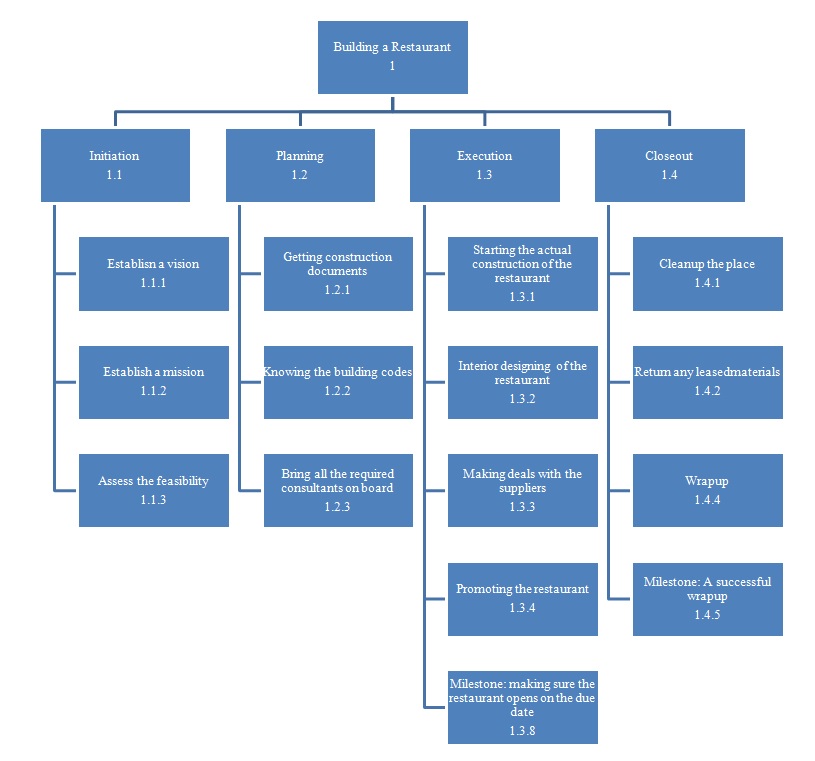Scheduling is absolutely essential for a successful project, and using visual depiction for managing activities makes it a lot easier for the teams to understand the relationships of the different tasks in a project. The two most commonly used such tools are Gantt and PERT charts. They help in establishing the relationships between the tasks, and they are also useful for task scheduling. Another such tool is the Critical Path Method, also known as CPM.
PERT
PERT stands for “Project Evaluation and Review Technique”. Simply put, it is a graphical representation of the schedule of the project, and it shows the sequence of the tasks (Kerzner). The purpose of the chart is to establish a critical path, which minimizes the time taken for the entire project’s completion (Kerzner). It helps the team in planning the entire project by explicitly showing the details of each step involved. Once the entire process is graphically expressed, the management team can easily schedule the different tasks accordingly so that no deadlines are missed. Furthermore, the control becomes easier since if any of the constituent tasks diverges from the planned critical path, it is very easily identified, and corrective actions can be taken.
Gantt Chart
Named after the developer Henry Gantt, it is a horizontal Bar chart that demonstrates a project schedule. The x-axis of the chart represents the time, and the y-axis shows the different tasks that need to be performed (Project Management Institute). The different bars of different lengths represent the different sequences and time durations of the different tasks involved. These charts clearly illustrate the project status, and have become a common technique used to illustrate the activities and phases of a project (Project Management Institute).
CPM Chart
CPM is a very effective tool for efficient project management. It works on an algorithm for the scheduling of different tasks. In order to execute CPM, the manager needs to know all the activities that need to be performed for the project, the duration of each activity and the dependencies between these activities (Klastorin). CPM focuses on finding the activities that are absolutely critical for the successful execution of the project, scheduling these activities and controlling the process.
Advantages and Disadvantages of these Techniques
All these techniques have numerous advantages; they provide excellent graphical representation of the constituent tasks of the project which makes the understanding of these tasks much easier. These charts also make the planning, scheduling and controlling of the entire project quite effective and efficient, but these methods also have some disadvantages, as well. Some of these disadvantages are general, but some are specific to each technique. For instance, in some cases trying to manage the project at such a level may take the manager’s eye off of the bigger picture, and the manager may lose track of the project in an attempt of micromanaging the tasks. For Example in case of a mega-project that probably has thousands of smaller tasks, it might take months, if not years, to draw a CPM. One of the biggest disadvantages of the Gantt charts in specific is that they do not illustrate task dependencies; they fail to explain the effect of failure of delay in one task on the rest of the tasks and the entire project. Another disadvantage is that, for instance in case of a PERT chart, the duration and other specifications of each task have to be forecasted or estimated, which may mean a lot of estimations, and later on the controlling of the entire project is based upon these estimates.
Significance of these Techniques in Monitoring and Controlling the Tasks
These techniques greatly help in planning, scheduling and controlling the projects because they make the entire process much easier by making it graphical. Each person in the team knows what needs to be done, who is responsible for it and when is it supposed to be done. If anything goes wrong, it is easier to identify the source of the problem and the probable impact it’s going to have on other tasks and the entire project. By knowing or estimating the details of each task the planning part of the project get simplified. Knowledge of these relationships and interdependencies of the tasks, the scheduling becomes a lot easier. By knowing the deadlines and significance of individual tasks the control becomes a lot easier, as well.

The details of tasks after the actual opening date are not being shown in the WBS because the running of the restaurant and achieving the desired performance are in practice different from the building of the project.
Works Cited
Kerzner, Harold. Project Management: A Systems Approach to Planning, Scheduling, and Controlling. New York: Wiley, 2003. Print.
Klastorin, Ted. Project Management: Tools and Trade-offs. New York: Wiley, 2003. Print.
Project Management Institute. A Guide To The Project Management Body Of Knowledge. San Diego: Project Management Institute, 2003. Print.